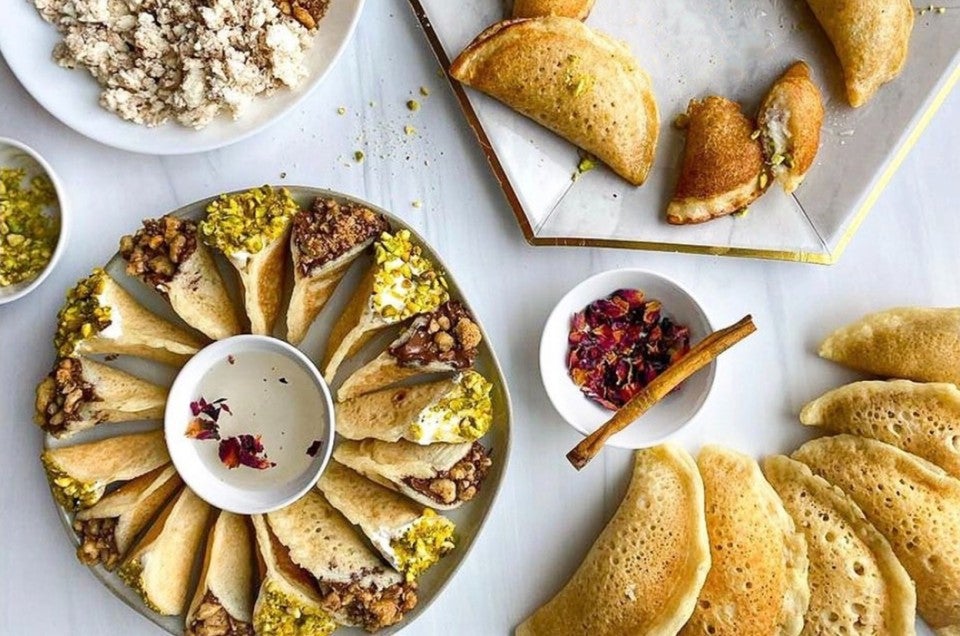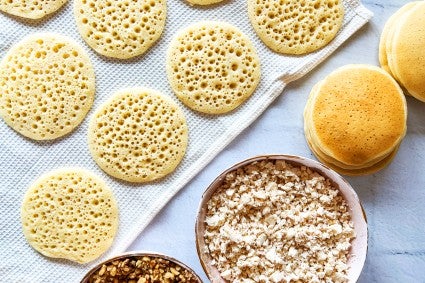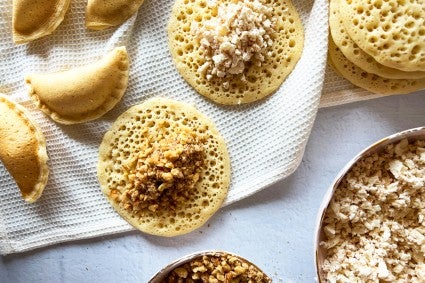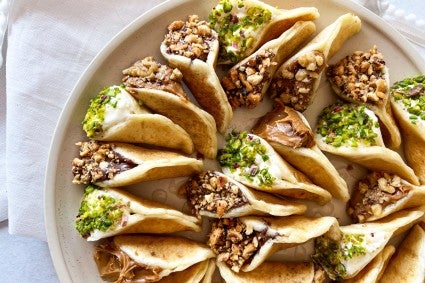These baked (not fried!) qatayef are my go-to Ramadan treat
For me, these stuffed semolina pancakes are wrapped up in nostalgia and family.


With Ramadan here, blogger Heifa Odeh of Fufu's Kitchen joins us to write about a beloved recipe she always makes this time of year: qatayef.
* * *
Qatayef are one of the most beloved desserts served during Ramadan, a holy month for Muslims worldwide during which we fast from sunrise to sunset by abstaining from food, beverages, and more. And after a long day of fasting, we always look forward to enjoying these sweet stuffed semolina pancakes at the end of a meal.
In my family, for as long as I can remember, making qatayef was a Ramadan tradition. Some of my favorite memories are of me in the kitchen with my mom, dad, and brothers forming an assembly line to make them together as a family. A week before Ramadan, we would cook and stuff batches of qatayef, then freeze them so we could enjoy all month long.
My mom and dad managed the griddle on the stove, where they would pour qatayef batter into round discs just like pancakes. (Unlike traditional pancakes, these aren’t flipped. They’re cooked on just one side: The other side, which is face up, has lots of distinct open holes.) Meanwhile, my brothers and I would be on the retrieving end, where we would grab the cooked qatayef and place them on a kitchen towel to cool before stacking them. We would snack on them while “working,” then as a family we stuffed the ones that were left with either sweet cheese, an ingredient common in Arab sweets and my personal favorite filling, or chopped walnuts accented with a warming touch of cinnamon. As a treat, we would save some unstuffed for the next morning and just drizzle honey on top to eat, a play on pancakes and syrup.
We always looked forward to this tradition, and now that I’m a mother myself, I can’t wait to recreate these beautiful memories with my husband and young son as he grows older.

Once cooked on the griddle and stuffed, these pancakes are often fried in hot oil until crisp. In my family, however, we always bake them instead, another option for preparing them. Our father is health-conscious and almost never eats fried foods, and my mother dislikes the smell and cleanup of frying. Personally, I find baking even better because the qatayef are less greasy, there’s less cleanup, and overall, it takes less effort.
You can simply place all the stuffed-and-sealed qatayef on a baking tray at once and pop them in the oven, rather than standing over a bubbling pot of hot oil and frying several batches. Broiling the qatayef for a minute at the end adds even more crispiness and golden color with little effort. Win-win, right?

Here is my full recipe for qatayef, where I share how to make the batter and fillings. There are different versions of qatayef across the Middle East, but as a Palestinian, I often enjoy them stuffed with cinnamon sugar-spiced walnuts or cheese with a dash of spice.
There is also a variation known as asafiri, where mini versions of the semolina pancakes are made and only one side is closed, and the open side is a funnel for ashta (a Middle Eastern cream filling) or even Nutella, an untraditional but nonetheless delicious bite that kids always love. I also like cookie butter as a filling. These remain un-baked, and they're often drizzled with simple syrup, particularly the ashta-filled versions.
Once stuffed, you can dip the open-ended side of the qatayef in chopped nuts or crushed cookies: I like chopped hazelnuts paired with Nutella, crushed speculoos cookies with cookie butter, and chopped pistachios with ashta.

I promise these are simple to make — especially by baking instead of frying — and the outcome is irresistible: You won’t stop at just one. The crispy edges soaked in orange blossom-infused syrup with a gooey cheese or aromatic nut filling — plus the endless options for non-traditional fillings — make them simply sensational. After all, there’s a reason why qatayef are the most popular and nostalgic of all Ramadan desserts.
Cover photo by Heifa Odeh.

